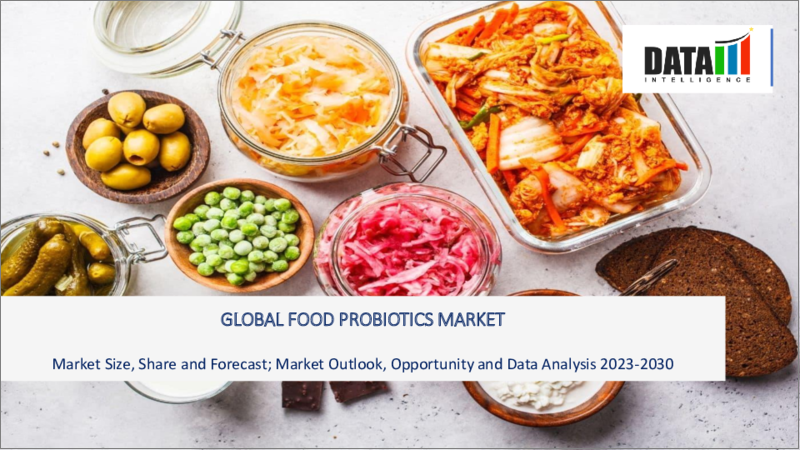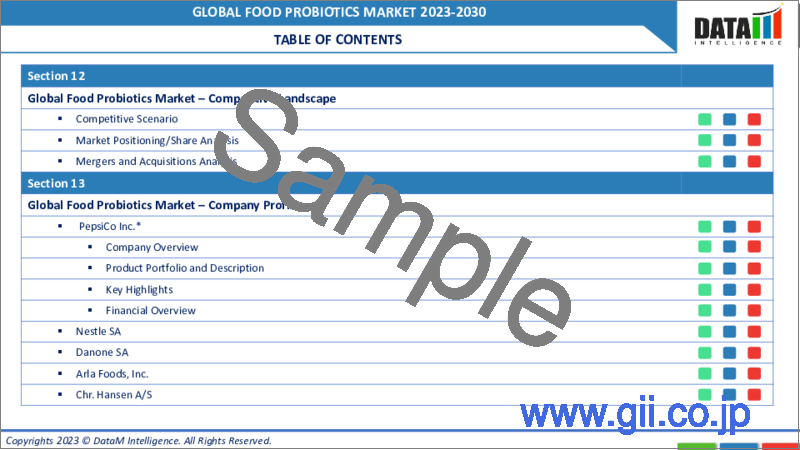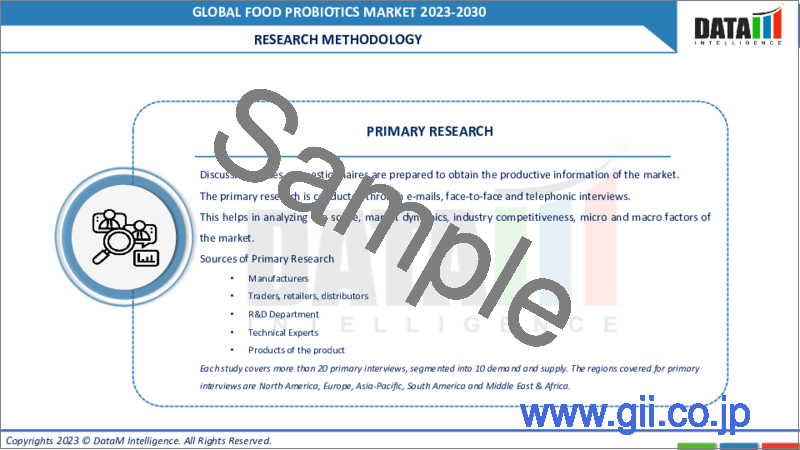|
|
市場調査レポート
商品コード
1290430
食品プロバイオティクスの世界市場- 2023-2030Global Food Probiotics Market - 2023-2030 |
||||||
カスタマイズ可能
適宜更新あり
|
|||||||
| 食品プロバイオティクスの世界市場- 2023-2030 |
|
出版日: 2023年06月12日
発行: DataM Intelligence
ページ情報: 英文 190 Pages
納期: 即日から翌営業日
|
- 全表示
- 概要
- 目次
市場概要
食品プロバイオティクスの世界市場は、2022年に605億米ドルに達し、2030年には1,001億米ドルに達すると予測され、予測期間2023-2030年のCAGRは6.5%で成長すると予測されています。
食品プロバイオティクスとは、生きた微生物、特にプロバイオティック株を含む食品を指し、摂取することで潜在的な健康効果が期待できます。これらのプロバイオティクス株は、消化管に存在する微生物のコミュニティである腸内細菌叢にプラスの影響を与えることができる有益な細菌または酵母です。
食品プロバイオティクス市場では、特定のプロバイオティクス菌株を含む製品への需要が高まっていることが確認されています。例えば、Regulatory Affairs Professionals Societyのレポートによると、2021年のプロバイオティクス市場全体の規模は480億米ドル以上とされています。消費者は、消化器系の健康にはラクトバチルス・アシドフィルス、免疫サポートにはビフィドバクテリウム・ラクティスなど、特定の健康効果を実証した、よく研究された菌株を含む製品を求めています。
市場力学
広範な科学研究と確かな臨床エビデンスが食品プロバイオティクス市場を牽引している
広範な科学研究と臨床研究により、食品プロバイオティクスの消費に関連する潜在的な健康上の利点の証拠が提供されています。これらの研究では、消化器系の健康、免疫機能、全体的な健康への影響など、プロバイオティクスのさまざまな側面が調査されています。プロバイオティクスのポジティブな効果を示す確かな科学的根拠が得られたことで、消費者やヘルスケア関係者の関心が高まり、プロバイオティクスを豊富に含む食品への需要が高まっています。
科学研究は、食品プロバイオティクス市場における技術革新の触媒として機能します。研究者とメーカーは、新しいプロバイオティクス菌株を継続的に調査し、その作用メカニズムを理解し、新たな健康効果を発見しています。このような科学的進歩は製品開発を促進し、新しいプロバイオティクス製剤やデリバリーシステムの導入を促し、進化する消費者の要求や嗜好に応えています。
老年人口の増加と消化器系の健康状態の悪化が大きなビジネスチャンスをもたらす
世界の人口は、高齢者の数が着実に増加しています。国連によると、60歳以上の人口は2050年までに21億人に達し、2017年の約2倍になると予測されています。高齢化社会は、便秘や胃腸障害、腸内細菌叢の多様性の低下など、消化器系の問題の発生率が高くなることが多いと言われています。
消化器系の健康問題は、世界中でますます蔓延しています。座りがちなライフスタイル、食生活の乱れ、ストレス、特定の薬剤の使用などの要因が、過敏性腸症候群(IBS)、炎症性腸疾患(IBD)、ディスバイオシスなどの消化器系の問題の原因になっています。これらの疾患は、個人の生活の質や全体的な幸福感に大きな影響を与える可能性があります。
限られた賞味期限が食品プロバイオティクス市場の足かせとなっている
食品プロバイオティクスは生きた培養物を含んでおり、温度、湿気、酸素などの環境要因に敏感です。これらの要因は、プロバイオティクス菌株の生存率と効力に影響を与える可能性があります。保存期間が限られているのは、主に時間の経過に伴う自然劣化と生菌数の減少が原因です。
食品プロバイオティクス市場には、異なるプロバイオティクス菌株や製品の最適な保存期間を決定するための標準化されたガイドラインがないです。プロバイオティクスの生存率は、菌株、製剤、包装、保存条件によって異なる可能性があります。明確なガイドラインがないため、メーカーが一貫して普遍的に受け入れられる賞味期限基準を確立することは困難です。
COVID-19の影響分析
COVID-19分析では、COVID前シナリオ、COVIDシナリオ、COVID後シナリオに加え、価格力学(COVID前シナリオと比較したパンデミック中・後の価格変動を含む)、需要-供給スペクトラム(取引制限、ロックダウン、その後の問題による需要と供給のシフト)、政府の取り組み(政府機関による市場、セクター、産業の活性化に関する取り組み)、メーカー戦略的取り組み(メーカーによるCOVID問題軽減への取り組み)についても解説しています。
目次
第1章 調査手法と範囲
- 調査手法
- 調査目的および調査範囲
第2章 市場の定義と概要
第3章 エグゼクティブサマリー
- 市場内訳:ソース別
- 市場内訳:用途別
- 市場内訳:エンドユーザー別
- 市場内訳:地域別
第4章 市場力学
- 市場影響因子
- 促進要因
- プロバイオティクスは、需要の高まりを受けて、医薬品の代わりに使用されることが多くなっています
- 抑制要因
- 伝染病が食品プロバイオティクス市場の妨げになる可能性があります
- 機会
- 影響分析
- 促進要因
第5章 産業分析
- ポーターのファイブフォース分析
- サプライチェーン分析
- 価格分析
- 法規制の分析
第6章 COVID-19の分析
第7章 ソース別
- 細菌
- ビフィドバクテリウム
- 乳酸菌
- アシドフィルス乳酸菌
- ラクトバチルス・カゼイ
- ラクトバチルス・ラムノサス
- ロイテリ乳酸菌
- イースト菌
第8章 用途別
- 動物用飼料
- 栄養補助食品
- 機能性食品・飲食品
- 焼成食品
- シリアル
- 乳製品
- 発酵肉
- 非乳製品飲料
第9章 エンドユーザー別
- 動物用プロバイオティクス
- ヒト用プロバイオティクス
第10章 地域別
- 北米
- 米国
- カナダ
- メキシコ
- 欧州
- ドイツ
- 英国
- フランス
- イタリア
- スペイン
- その他欧州
- 南米
- ブラジル
- アルゼンチン
- その他南米地域
- アジア太平洋地域
- 中国
- インド
- 日本
- オーストラリア
- その他アジア太平洋地域
- 中東・アフリカ地域
第11章 競合情勢
- 競合シナリオ
- 市況/シェア分析
- M&A(合併・買収)分析
第12章 企業プロファイル
- Arla Foods, Inc.
- 会社概要
- 製品ポートフォリオと説明
- 財務概要
- 主な発展状況
- BioGaia AB
- Chr. Hansen Holding A/S
- Danone
- Danisco A/S
- General Mills, Inc.
- I-Health Inc.
- Lallemand Inc.
- Lifeway Foods Inc.
- Mother Dairy Fruit & Vegetable Pvt. Ltd.
第13章 付録
Market Overview
The Global Food Probiotics Market reached US$ 60.5 billion in 2022 and is expected to reach US$ 100.1 billion by 2030 and is expected to grow with a CAGR of 6.5% during the forecast period 2023-2030.
Food probiotics refer to food products that contain live microorganisms, specifically probiotic strains, which provide potential health benefits when consumed. These probiotic strains are beneficial bacteria or yeasts that can positively influence the gut microbiota, the community of microorganisms residing in the gastrointestinal tract.
The food probiotics market is witnessing a growing demand for products containing specific strains of probiotics. For instance, a report by Regulatory Affairs Professionals Society says that the total probiotic market was worth more than US$ 48 billion in 2021. Consumers are seeking out products with well-researched strains that have demonstrated specific health benefits, such as Lactobacillus acidophilus for digestive health or Bifidobacterium lactis for immune support.
Market Dynamics
Extended Scientific Research and Solid Clinical Evidence Are Driving the Food Probiotics Market
Extensive scientific research and clinical studies have provided evidence of the potential health benefits associated with the consumption of food probiotics. These studies have explored various aspects of probiotics, such as their impact on digestive health, immune function, and overall well-being. The availability of solid scientific evidence showcasing the positive effects of probiotics has generated interest among consumers and healthcare professionals, driving the demand for probiotic-rich food products.
Scientific research acts as a catalyst for innovation in the food probiotics market. Researchers and manufacturers are continuously exploring new probiotic strains, understanding their mechanisms of action, and uncovering novel health benefits. This scientific advancement fuels product development and drives the introduction of new probiotic formulations and delivery systems, meeting evolving consumer demands and preferences.
An Increase in Geriatric Population and Poor Digestive Health Provide Remarkable Opportunity
The global population is experiencing a steady increase in the number of elderly individuals. According to the United Nations, the number of people aged 60 years and above is projected to reach 2.1 billion by 2050, nearly double the number in 2017. The aging population is often associated with a higher incidence of digestive issues, such as constipation, gastrointestinal disorders, and a decline in gut microbiota diversity.
Digestive health issues are becoming increasingly prevalent worldwide. Factors such as sedentary lifestyles, poor dietary choices, stress, and the use of certain medications contribute to digestive problems like irritable bowel syndrome (IBS), inflammatory bowel disease (IBD), and dysbiosis. These conditions can significantly impact the quality of life and overall well-being of individuals.
Limited Shelf Life is Holding Back the Food Probiotics Market
Food probiotics contain live cultures, which are sensitive to environmental factors such as temperature, moisture, and oxygen. These factors can affect the viability and potency of the probiotic strains. The limited shelf life is primarily due to the natural degradation and decline in the number of live cultures over time.
The food probiotics market lacks standardized guidelines for determining the optimal shelf life of different probiotic strains and products. The viability of probiotics can vary depending on the strain, formulation, packaging, and storage conditions. The absence of clear guidelines can make it challenging for manufacturers to establish consistent and universally accepted shelf life standards.
COVID-19 Impact Analysis
The COVID-19 Analysis includes Pre-COVID Scenario, COVID Scenario, and Post-COVID Scenario along with Pricing Dynamics (Including pricing change during and post-pandemic comparing it with pre-COVID scenarios), Demand-Supply Spectrum (Shift in demand and supply owing to trading restrictions, lockdown, and subsequent issues), Government Initiatives (Initiatives to revive market, sector or Industry by Government Bodies) and Manufacturers Strategic Initiatives (What manufacturers did to mitigate the COVID issues will be covered here).
Segment Analysis
The global food probiotics market is segmented based on source, application, end-user, and region.
By Source, the Bacteria Segment is Estimated to have Significant Growth During the Forecast Period
Bacteria are naturally occurring microorganisms that are present in various environments, including the human body. They play a crucial role in maintaining a healthy balance within the gut microbiota. Probiotic bacteria, such as Lactobacillus and Bifidobacterium strains, are commonly used in food probiotics due to their well-documented health benefits.
Bacterial strains used in food probiotics have generally undergone rigorous safety assessments and regulatory approvals. For instance, many bacterial strains have obtained Generally Recognized as Safe (GRAS) status from regulatory authorities, indicating their safety for consumption. This regulatory approval instills confidence in manufacturers and consumers regarding the use of bacterial strains in food probiotics.
Geographical Analysis
North America is the Fastest Growing Market in The Food Probiotics Market
In recent years, there has been a significant increase in consumer awareness and interest in digestive health, immune support, and overall wellness. Consumers in North America are actively seeking out functional foods and beverages, including probiotics, to support their health goals. This rising awareness and adoption of probiotic products have contributed to the growth of the market in the region.
North America has a regulatory framework that supports the development and marketing of probiotic products. For instance, regulatory authorities, such as the U.S. Food and Drug Administration (FDA) and Health Canada, have established guidelines and standards for the use of probiotics in food and dietary supplements. This supportive regulatory environment fosters innovation, encourages investment, and facilitates the introduction of new probiotic products into the market.
Competitive Landscape
The major global players in the market include: Arla Foods, Inc., BioGaia AB, Chr. Hansen Holding A/S, Danone, Danisco A/S, General Mills, Inc., I-Health Inc., Lallemand Inc., Lifeway Foods Inc., and Mother Dairy Fruit & Vegetable Pvt. Ltd.
Why Purchase the Report?
- To visualize the global food probiotics market segmentation based on source, application, end-user, and region, as well as understand key commercial assets and players.
- Identify commercial opportunities in the market by analyzing trends and co-development.
- Excel data sheet with numerous data points of food probiotics market-level with all segments.
- The PDF report consists of cogently put-together market analysis after exhaustive qualitative interviews and in-depth market study.
- Product mapping is available as Excel consists of key products of all the major market players.
The global food probiotics market report would provide approximately 61 tables, 59 figures and 190 pages.
Target Audience 2023
- Manufacturers/ Buyers
- Industry Investors/Investment Bankers
- Research Professionals
- Emerging Companies
Table of Contents
1. Methodology and Scope
- 1.1. Research Methodology
- 1.2. Research Objective and Scope of the Report
2. Market Definition and Overview
3. Executive Summary
- 3.1. Market Snippet, by Source
- 3.2. Market Snippet, by Application
- 3.3. Market Snippet, by End User
- 3.4. Market Snippet, by Region
4. Market Dynamics
- 4.1. Market Impacting Factors
- 4.1.1. Drivers
- 4.1.1.1. Probiotics are increasingly being used in place of pharmaceuticals as a response to rising demand
- 4.1.2. Restraints
- 4.1.2.1. Contagious hazard can hamper the food probiotics market
- 4.1.3. Opportunity
- 4.1.4. Impact Analysis
- 4.1.1. Drivers
5. Industry Analysis
- 5.1. Porter's Five Force Analysis
- 5.2. Supply Chain Analysis
- 5.3. Pricing Analysis
- 5.4. Regulatory Analysis
6. COVID-19 Analysis
- 6.1. Analysis of COVID-19 on the Market
- 6.1.1. Scenario Before COVID-19
- 6.1.2. Scenario During COVID-19
- 6.1.3. Scenario Post COVID-19
- 6.2. Pricing Dynamics Amid COVID-19
- 6.3. Demand-Supply Spectrum
- 6.4. Government Initiatives Related to the Market During Pandemic
- 6.5. Manufacturers Strategic Initiatives
- 6.6. Conclusion
7. By Source
- 7.1. Introduction
- 7.1.1. Market Size Analysis and Y-o-Y Growth Analysis (%), By Source
- 7.1.2. Market Attractiveness Index, By Source
- 7.2. Bacteria*
- 7.2.1. Introduction
- 7.2.2. Market Size Analysis and Y-o-Y Growth Analysis (%)
- 7.2.3. Bifidobacterium
- 7.2.4. Lactobacilli
- 7.2.4.1. Lactobacillus Acidophilus
- 7.2.4.2. Lactobacillus Casei
- 7.2.4.3. Lactobacillus Rhamnosus
- 7.2.4.4. Lactobacillus Rheuteri
- 7.3. Yeast
8. By Application
- 8.1. Introduction
- 8.1.1. Market Size Analysis and Y-o-Y Growth Analysis (%), By Application
- 8.1.2. Market Attractiveness Index, By Application
- 8.2. Animal Feed*
- 8.2.1. Introduction
- 8.2.2. Market Size Analysis and Y-o-Y Growth Analysis (%)
- 8.3. Dietary Supplements
- 8.4. Functional Food & Beverages
- 8.4.1. Baked Goods
- 8.4.2. Cereal
- 8.4.3. Dairy Products
- 8.4.4. Fermented Meat
- 8.4.5. Non-Dairy Beverages
9. By End-User
- 9.1. Introduction
- 9.1.1. Market Size Analysis and Y-o-Y Growth Analysis (%), By End-User
- 9.1.2. Market Attractiveness Index, By End-User
- 9.2. Animal Probiotics*
- 9.2.1. Introduction
- 9.2.2. Market Size Analysis and Y-o-Y Growth Analysis (%)
- 9.3. Human Probiotics
10. By Region
- 10.1. Introduction
- 10.1.1. Market Size Analysis and Y-o-Y Growth Analysis (%), By Region
- 10.1.2. Market Attractiveness Index, By Region
- 10.2. North America*
- 10.2.1. Introduction
- 10.2.2. Key Region-Specific Dynamics
- 10.2.3. Market Size Analysis and Y-o-Y Growth Analysis (%), By Source
- 10.2.4. Market Size Analysis and Y-o-Y Growth Analysis (%), By Application
- 10.2.5. Market Size Analysis and Y-o-Y Growth Analysis (%), By End-User
- 10.2.6. Market Size Analysis and Y-o-Y Growth Analysis (%), By Country
- 10.2.6.1. The U.S.
- 10.2.6.2. Canada
- 10.2.6.3. Mexico
- 10.3. Europe
- 10.3.1. Introduction
- 10.3.2. Key Region-Specific Dynamics
- 10.3.3. Market Size Analysis and Y-o-Y Growth Analysis (%), By Source
- 10.3.4. Market Size Analysis and Y-o-Y Growth Analysis (%), By Application
- 10.3.5. Market Size Analysis and Y-o-Y Growth Analysis (%), By End-User
- 10.3.6. Market Size Analysis and Y-o-Y Growth Analysis (%), By Country
- 10.3.6.1. Germany
- 10.3.6.2. The U.K.
- 10.3.6.3. France
- 10.3.6.4. Italy
- 10.3.6.5. Spain
- 10.3.6.6. Rest of Europe
- 10.4. South America
- 10.4.1. Introduction
- 10.4.2. Key Region-Specific Dynamics
- 10.4.3. Market Size Analysis and Y-o-Y Growth Analysis (%), By Source
- 10.4.4. Market Size Analysis and Y-o-Y Growth Analysis (%), By Application
- 10.4.5. Market Size Analysis and Y-o-Y Growth Analysis (%), By End-User
- 10.4.6. Market Size Analysis and Y-o-Y Growth Analysis (%), By Country
- 10.4.6.1. Brazil
- 10.4.6.2. Argentina
- 10.4.6.3. Rest of South America
- 10.5. Asia-Pacific
- 10.5.1. Introduction
- 10.5.2. Key Region-Specific Dynamics
- 10.5.3. Market Size Analysis and Y-o-Y Growth Analysis (%), By Source
- 10.5.4. Market Size Analysis and Y-o-Y Growth Analysis (%), By Application
- 10.5.5. Market Size Analysis and Y-o-Y Growth Analysis (%), By End-User
- 10.5.6. Market Size Analysis and Y-o-Y Growth Analysis (%), By Country
- 10.5.6.1. China
- 10.5.6.2. India
- 10.5.6.3. Japan
- 10.5.6.4. Australia
- 10.5.6.5. Rest of Asia-Pacific
- 10.6. Middle East and Africa
- 10.6.1. Introduction
- 10.6.2. Key Region-Specific Dynamics
- 10.6.3. Market Size Analysis and Y-o-Y Growth Analysis (%), By Source
- 10.6.4. Market Size Analysis and Y-o-Y Growth Analysis (%), By Application
- 10.6.5. Market Size Analysis and Y-o-Y Growth Analysis (%), By End-User
11. Competitive Landscape
- 11.1. Competitive Scenario
- 11.2. Market Positioning/Share Analysis
- 11.3. Mergers and Acquisitions Analysis
12. Company Profiles
- 12.1. Arla Foods, Inc.*
- 12.1.1. Company Overview
- 12.1.2. Product Portfolio and Description
- 12.1.3. Financial Overview
- 12.1.4. Key Developments
- 12.2. BioGaia AB
- 12.3. Chr. Hansen Holding A/S
- 12.4. Danone
- 12.5. Danisco A/S
- 12.6. General Mills, Inc.
- 12.7. I-Health Inc.
- 12.8. Lallemand Inc.
- 12.9. Lifeway Foods Inc.
- 12.10. Mother Dairy Fruit & Vegetable Pvt. Ltd.
LIST NOT EXHAUSTIVE
13. Appendix
- 13.1. About Us and Services
- 13.2. Contact Us





